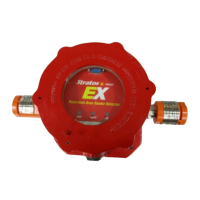Chapter 1: Introduction
4 Stratos EX Hazardous Area Aspirating Smoke Detection System Installation Manual
Do not install electronic assemblies prior to mounting and attaching conduit for
field wiring to the enclosure. Before making modifications, verify that they will not
interfere with battery and printed circuit board locations. Do not overtighten screw
terminals. Overtightening may damage threads, resulting in reduced terminal
contact pressure and difficulty with screw terminal removal.
This system contains static-sensitive components. Always ground yourself with a
proper wrist strap before handling any circuits so that static charges are removed
from the body. Use static suppressive packaging to protect electronic assemblies
removed from the control unit.
Follow the instructions in this manual. These instructions must be followed to
avoid damage to the control unit and associated equipment. System operation
and reliability depend upon proper installation.
Caution: While installing a fire alarm system may make lower insurance rates
possible, it is not a substitute for insurance. An automatic fire alarm system or
components of a system—smoke detectors, heat detectors, manual pull stations,
notification appliances, and a fire alarm control unit with remote-notification
capability—can provide early warning of a developing fire. Such a system,
however, does not assure protection against property damage or loss of life
resulting from a fire.
Aspirating smoke detection system
limitations
An aspirating smoke detection system—which can be made up of smoke
detectors, heat detectors, manual pull stations, notification appliances, and a fire
alarm control unit with remote-notification capability—can provide early warning
of a developing fire. Such a system, however, does not assure protection against
property damage or loss of life resulting from a fire.
Any fire alarm system may fail for a variety of reasons. The following are only
examples:
• Smoke detectors may not sense fire where smoke cannot reach the
detectors, such as in chimneys, in walls, on roofs, or on the other side of
closed doors.
• Smoke detectors on one level also may not sense a fire on another level or
floor of a building. A second floor detector, for example, may not sense a first
floor or basement fire.
• All types of smoke detectors—ionization, photoelectric and air aspirating—
have sensing limitations. No type of smoke detector can sense every kind of
fire caused by carelessness and safety hazards such as smoking in bed,
escaping gas, improper storage of flammable materials, overloaded electrical
circuits, or arson.

